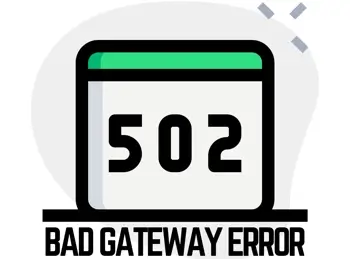What Is 502 Bad Gateway Error? How to Fix 502 Bad Gateway
Encountering errors while browsing the Internet is a common occurrence. One such error that can disrupt your online experience is the 502 Bad Gateway error. This error can be frustrating, especially if you don't know what it means or how to fix it. In this article, learn what the 502 Bad Gateway error is, why it appears, and how you can resolve it.
What is a 502 Bad Gateway error?
A 502 Bad Gateway error is an HTTP status code that indicates a problem with the communication between servers. When you visit a website, your browser sends a request to the web server hosting the site. If something goes wrong in this process and one server receives an invalid response from another server, you will see the 502 Bad Gateway error.
What does 502 Bad Gateway mean?
Essentially, a 502 Bad Gateway error means that the server acting as a gateway or proxy received an invalid response from the upstream server. This upstream server could be another web server, a database server, or any other service that the gateway server relies on to fulfill the request.
Common causes of the 502 Bad Gateway error
There are several reasons why you might encounter a 502 Bad Gateway error.
- Server overload. When the server is overwhelmed with too many requests, it may fail to respond properly, resulting in a 502 error.
- Network issues. Problems with the network between servers can cause communication failures.
- Server configuration errors. Misconfigurations in the server settings can lead to invalid responses going to the gateway server, resulting in the error.
- DNS issues. Domain name system (DNS) problems can prevent the gateway server from correctly locating the upstream server.
- Firewall blocks. Firewalls might mistakenly block legitimate requests, causing a 502 error.
- Faulty plugins or extensions. In some cases, plugins or extensions in your web browser can interfere with the server's response.

Understanding real-world instances where the 502 Bad Gateway error has caused significant issues can provide better insight into its impact. Consider major e-commerce websites during high-traffic events like Black Friday or Cyber Monday. During these events, major e-commerce websites can experience server overloads, leading to 502 errors. This not only affects sales but also customer trust and satisfaction.
Furthermore, social media platforms with millions of users, like Twitter or Facebook, might encounter 502 errors during peak times or when releasing new features. These errors can disrupt user engagement and affect the platform's reliability.
How to fix the 502 Bad Gateway error
Once you understand the potential causes of a 502 Bad Gateway error, you can move forward in fixing it. There are a few ways to fix a 502 Bad Gateway error, but try each step to ensure you cover all your bases in solving the problem.
Refresh the page
Sometimes, a 502 error is temporary and can be resolved by simply refreshing the webpage. Press F5 or click the refresh button in your browser to see if the problem goes away.
Check the server status
If refreshing the page doesn't work, check if the website itself is down. You can use online tools like "Is It Down Right Now?" or "Down For Everyone or Just Me?" to see if others are experiencing the same issue.
Clear your browser cache
A corrupted cache can unfortunately cause issues with all loading webpages. If you're still struggling, clear your browser cache to ensure that you're loading the latest version of the website.
- To clear your browser cache on Chrome, go to Settings > Privacy and Security > Clear browsing data.
- To clear your browser cache on Firefox, go to Options > Privacy and Security > Clear data.
- To clear your browser cache on Edge, go to Settings > Privacy, search, and services > Choose what to clear.
Disable your browser extensions
Extensions or plugins might interfere with the server response. Try disabling them temporarily to see if the error resolves.
- For Chrome, go to More tools > Extensions and disable them.
- For Firefox, go to Add-ons > Extensions and disable them.
- For Edge, go to Extensions and disable them.
Restart your network devices
Sometimes, the problem lies with your network devices. Restart your router and modem by unplugging them for about 30 seconds and then plugging them back in.
Check your DNS settings
Incorrect DNS settings can cause connectivity issues. Try changing your DNS server to a more reliable one, like Google DNS (8.8.8.8) or Cloudflare DNS (1.1.1.1).
- For Windows, go to Control Panel > Network and Internet > Network and Sharing Center > Change adapter settings. Right-click your connection and select Properties. Select TCP/IPv4 and click Properties, then enter the new DNS server addresses.
- For Mac, go to System Settings > Network. Select your connection and click Advanced. Go to the DNS tab and add the new DNS server addresses.
Contact the website administrator
If none of the above solutions work, then the issue might be on the server side. Contact the website's administrator to report the problem.
Advanced troubleshooting for 502 Bad Gateway errors
If basic troubleshooting steps don't resolve the issue, then more advanced methods might be necessary. Try checking the server logs, as these can provide detailed information about what might be causing the 502 error. Look for error messages or patterns that indicate a specific problem.
If you're a developer, debugging the code that handles server requests can help identify issues. Look for bugs or inefficiencies in the code that might be causing invalid responses. Additionally, if your server is frequently overloaded, consider upgrading your server resources. This could involve increasing memory, CPU, or bandwidth to handle more requests simultaneously.
How to prevent 502 Bad Gateway errors
To minimize the occurrence of 502 Bad Gateway errors, implement the following preventative measures.
- Load balancing. Use load balancers to distribute incoming traffic evenly across multiple servers. This can prevent any single server from becoming overwhelmed.
- Regular maintenance. Perform regular maintenance on your servers to ensure that they are running efficiently. This includes updating software, fixing bugs, and optimizing performance.
- Scalable infrastructure. Design your infrastructure to be scalable, allowing it to handle increased traffic without compromising performance. Cloud-based solutions can provide the flexibility to scale resources as needed.
- Monitoring and alerts. Set up monitoring and alert systems to detect and notify you of any server issues promptly. This allows for quick response and resolution before the problem escalates.
Encountering a 502 Bad Gateway error can be frustrating, but understanding its causes and knowing how to fix it can help you resolve the issue quickly. Whether the problem lies with server overloads, network issues, or DNS problems, following the steps outlined in this article can help you get back online smoothly.
If the error persists, contacting the website administrator is your best bet. Stay informed and proactive, and you'll be better equipped to handle any 502 Bad Gateway errors that come your way.
Frequently asked questions
Is a 502 Bad Gateway my fault?
No, a 502 Bad Gateway error is not your fault. It typically indicates an issue with the server or the network between servers, not with your device or browser.
Does 502 Bad Gateway go away on its own?
Sometimes, the 502 Bad Gateway error can resolve itself if the issue was temporary, such as a momentary server overload. However, if the problem persists, further action might be required.
What is the difference between 504 and 502 gateway errors?
A 504 Gateway Timeout error indicates that the server acting as a gateway did not receive a timely response from the upstream server. In contrast, a 502 Bad Gateway error means the gateway server received an invalid response from the upstream server.
Can browser extensions cause a 502 Bad Gateway error?
Yes, sometimes browser extensions can interfere with server responses, thus leading to a 502 Bad Gateway error. Disabling your extensions can help determine if one of them is the cause.
How can I prevent 502 Bad Gateway errors on my website?
To prevent 502 Bad Gateway errors on your website, ensure your servers are properly configured and capable of handling the traffic. Regularly update your software, monitor server performance, and use reliable DNS services.
Is there a way to track 502 Bad Gateway errors?
Yes, you can use website monitoring tools like Pingdom, New Relic, or UptimeRobot to track and alert you of any 502 Bad Gateway errors on your site. These tools can help you identify the root cause and resolve it quickly.
What other HTTP status codes should I be aware of?
Aside from the 502 Bad Gateway error, there are several other HTTP status codes you might encounter. They comparatively mean different things, but the most common ones are:
- 200 OK, meaning the request was successful.
- 404 Not Found, meaning the requested resource couldn't be found.
- 500 Internal Server Error, meaning the server encountered a problem.
- 503 Service Unavailable, meaning the server is temporarily unable to handle the request, often due to maintenance or an overload.
Can a 502 Bad Gateway error affect my site's security?
While a Bad Gateway error code 502 itself does not directly impact security, frequent errors can expose underlying vulnerabilities. Therefore, ensure your server configurations and software are up-to-date to prevent security risks.
How does a content delivery network (CDN) help with 502 errors?
A content delivery network can help mitigate 502 errors by caching content closer to users and balancing the load across multiple servers. This then reduces the likelihood of server overload and improves site performance.

